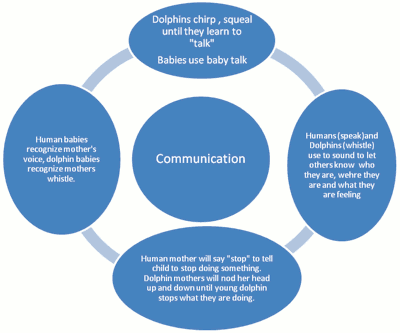BioMusic
| Author: | Debra Hall & Crystal Patillo |
| Level: | Elementary School |
| Content Area: | Science, Music |
| Author: | Debra Hall & Crystal Patillo |
| Level: | Elementary School |
| Content Area: | Science, Music |
Dolphins and humans share many characteristics. Dolphins use soundsand body language to communicate and express similar interactions that occur in human parent/child relationships.
The learner will find several similarities between the way humans and dolphins use sound to communicate and express them in a Venn diagram.
National Science Education Standards
Content Standard A: Abilities necessary to do scientific inquiry
Content Standard B: Physical Science
Content Standard C: Life Science
Content Standard E: Science and Technology
Content Standard F: Science in Personal and Social Perspectives
Content Standard G: History and Nature of Science
Goal 4: The learner will compose and arrange music within specified guidelines. (National Standard 4)
Goal 8: The learner will understand relationships between music, the other arts, and content areas outside the arts. (National Standard 8)
one 60 minute period
Book “Dolphin talk: Whistles, Clicks and Clapping Jaws”
Tell students that you can whistle your own name and then whistle out the number of syllables that you have in your own name putting the accent on the correct syllable. For example Beverly would have three syllables with the first one being the loudest Bev’-er- ly. Have the students work with a partner to come up with a way to represent their name using whistles and clicks. Share “dolphin talk” names.
Read the Book “Dolphin Talk: Whistles, Clicks and Clapping Jaws” to the students. Make a list of all the ways dolphins communicate and the sounds they make with it. The list should include clicks, whistles, squeaks, chirp, releasing bubbles, movement-nodding, popping noises, clapping jaws, slapping tails, hit water with entire body, soft, gentle sounds when showing affection, rattle, burp, moan and groan
Use a Venn diagram or other graphic organizer to compare the way dolphins and humans communicate.

Have students explain what some of these noises might sound like. Give students a variety of materials including balloons, whistles, straws, kazoo, pan pipe and a pail of water to allow them to experiment making dolphin sounds. The teacher may demonstrate a dolphin’s sound using a pitch pipe. Have the students do a short presentation to the class of the sounds they created. Have them demonstrate what the dolphin noises are and act out with a partner what they mean. See if the rest of the class can guess what the dolphin is communicating. Re-read Dolphin talk: Whistles, Clicks and Clapping Jaws. Allow students to add their dolphin interpretations to accompany the dramatization of the story.
Explore commonalities of dolphins and humans through the blind. Visually impaired humans use echolocation with the chirping of traffic walking signals. They also use their cane and glasses to echolocate.
Listen to the dolphins sing jazz and the Batman theme song at Epcot. Explore and compare work songs to spirituals.
Graphic organizer
Participation during dolphin name game.
Presentations of dolphin sounds using a variety of instruments. (balloon, mouth etc)